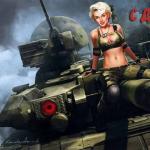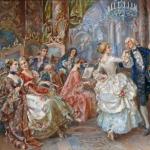Embroidery on knitwear patterns from a to z. Embroidery on knitwear with woolen threads for beginners
Embroidery on knitwear: we decorate clothes with our own hands (diagrams)
Today it is not often possible to meet craftswomen who would use embroidery on knitwear. But from this it has not lost its relevance and novelty. Knitwear embroidery is a great way to attract a simple product attention and make it extraordinary. But it is not so easy to complete it, and before starting practice, it would not hurt to get acquainted with the secrets of experienced needlewomen. 





Materials and rules of embroidery
In order for the work to bring pleasure, and the result to please you, you need to choose the right schemes and all the materials and accessories necessary for needlework. And, of course, you can’t do without the appropriate attitude, because you have to work hard. 
So, to work on knitwear embroidery, you will need the following materials and tools:
- knitted fabric;
- needles with a large eye;
- threads for embroidery and for basting;
- tracing paper;
- pencil.
In order to obtain a satisfactory result when embroidering knitwear, the following rules must be observed:
- select threads for embroidery, the thickness of which will correspond to the thickness of the thread from which the product itself is knitted;
- do not use threads that may shed on knitwear. Check them for color fastness before use.
Transferring a pattern to fabric
First you need to create clear boundaries for your drawing, for which you need to transfer the drawing to the fabric. Since knitted fabrics can have different densities, the methods for translating the pattern can also differ.
If you took loose hand knitwear for work, then you need to use tracing paper. First, the pattern is transferred to it, and then the tracing paper is placed on the knitwear and sewn to the canvas with a light basting seam. Then you need to outline the outlines of the scheme with a thread of a contrasting color and tear off the tracing paper. If you need to more clearly outline the contours of the picture, you can additionally walk along it stalk suture.





It is quite difficult to embroider on loose knitwear, as the stitches can fail, but this can be avoided by making a gauze or non-woven backing. After the work is completed, the edge of the substrate is trimmed.
If you use hand or machine jersey of considerable density, as we do, then do it a little differently. First, transfer the drawing to tracing paper in the same way and sweep it along the outline of the diagram. And then make a basting in the form of a grid with a cell size of 10 x 10 cm. This will help the canvas to hold securely and not move during embroidery.
With help sewing machine Stitch the outline of the pattern, being careful not to pull the canvas. Before you begin to embroider, remove the basting threads and tracing paper.
If embroidery is done on dark knitwear, then there is interesting way transfer the necessary patterns to it. To do this, take a polymer tracing paper, put it on the product and make holes with a thick needle along the outline of the circuit. Next, the tracing paper is sewn with a basting seam to the canvas. And a concentrated soap solution is applied over the tracing paper. When it dries, clear contours will remain on the canvas, which will allow you to embroider the desired patterns on them. If for some reason such a trace remains visible after the end of the work, then it can be easily removed by steaming.
Thread selection

Embroidery on knitwear separates the threads according to the type of material from which they are made, they can be woolen, synthetic or silk. The main thing is that they are sufficiently plastic, soft and fit well on the canvas. It is better not to use cotton and viscose threads. Some of them are too smooth and can make the knit stiff, while others are too twisted and can tangle. You should not take too fluffy threads, they also will not decorate knitwear.
If the knitwear is thin, then you can even embroider it with floss. But in our case, it is best to take threads of the same quality as the product, then the pattern will look as organic as possible. You can even create an effect, as if this pattern was already on knitwear. Acrylic or viscose threads are suitable for this.
Seam selection
Any seams can be used for knitwear. For example, it may be a seam of those used for a woven fabric. But for the most part, the choice of stitch depends on what scheme or pattern you are going to embroider. The seam can emphasize the texture of knitwear. If you take a knitted sweater, as in our case, then it is better to embroider with a buttonhole stitch, as it exactly repeats the pattern of a knitted fabric. 




But if your knitwear is thinner, then it is better to embroider it with a satin stitch or a cross, or with a “goat” finishing seam. A pattern made with such a seam will not weigh down knitwear. 





Knitwear embroidery

Embroidery on knitwear can be done with any known seam. Be sure to use lining fabric, this will help to avoid contraction of the pattern. To embroider such wonderful herons as in the photo, we will use a loop-in-loop stitch. It is very simple and can be embroidered on any knitwear.
First you need to consider that one cell will correspond to one loop. This is very convenient and for this reason, embroidery on various knitwear is often done with a cross. Thus, the choice of scheme will not be a problem for you.
We find the widest place on our diagram and start embroidering from there. We need to bring the thread under the loop that we have to embroider and insert the needle from right to left above this loop. Pass the thread. Then bring the needle to the place where you stuck it in and at the same height, insert the needle under the next loop. You have a loop. In the same way, the entire product is embroidered, according to the pattern that you applied.
Embroider first in one color, then take another and so on. You should not try to embroider at the same time with several needles with different threads, as they can get tangled on the wrong side and ruin your work.
Care of knitwear after embroidery 
So, we have a finished sweater with a pattern. We made sure that the selected threads do not shed, so the jersey can be washed. But you need to do it right. By following the following recommendations, you can easily keep the thing new, and the picture bright:
- before soaking knitwear, be sure to turn it inside out;
- use detergents for knitwear;
- do not rub or squeeze the item when washing it by hand;
- do not wash knitwear with other products;
- The water temperature for washing knitwear should not exceed 30 degrees. So you will avoid felting wool, and knitwear will not lose elasticity;
- knitwear, on which there are several colors, like ours, should not be soaked;
- the washing mode in the machine should be delicate.
When you're done washing, don't twist the sweater, but wring it out lightly. Then put it in terry towel, wrap and let excess moisture soak.
Drying should be carried out on a flat surface, away from the radiator.
You need to iron the sweater from the wrong side, making sure that it does not stretch. The heating temperature of the iron should be low.
We learned how to embroider on knitwear, decorating knitted fabric with a pattern. And now you can do something similar with other hand-knitted or store-bought items. Patterns are very easy to pick up on the Internet or even come up with your own.
If knitted things have lost their original appearance, and you don’t want to part with them, you can decorate them with an ornament. Properly selected embroidery on knitted fabric can bring your favorite things back to life. In this way, you can embroider and decorate not only the clothes of adults, but also on a hat or scarf for children. Flowers or complex pictures - you can master all this by reading our article or watching a video.
Before starting work, it is worth paying attention to some rules for embroidering. They will provide an easy process of creating patterns and a beautiful, neat appearance finished product.
- Look at the product you are going to work with. Determine the thickness of the yarn that was used to knit this item. When embroidering with a thin thread, the pattern will turn out to be sloppy, it will not be able to hide the threads of the product. Embroidery with too thick yarn will look untidy. Therefore, choose a thread of the same thickness as the product, then the pattern will fit perfectly into the overall look of the thing.
- During operation, do not tighten the loops of the product itself too much, otherwise you will get a damaged, tight and shapeless thing.
- Choose the right needles. They should be blunt and not very thin, with a large eye. Such needles will easily pass through the product without clinging, and without delamination of its structure.
- Choose yarn for work based on the material of the product. For buttonhole embroidery, select threads of the same or similar composition. If you are going to embroider with satin stitch, stop at threads with the addition of viscose. And natural silk yarn is also perfect.
- If, when embroidering with satin stitch, the fabric of the product peeks out between the stitches, fill the gaps with iris threads. Such patterns look very unusual.
- To prepare the product for embroidery, it is recommended to moisten it with water and then let it dry. This technique will help align the loops and ensure the quality of the pattern.
- Buy only high-quality yarn, without knots and irregularities. The thread should be strong and uniform, not strongly twisted.
Following these simple but very useful tips, you will not experience problems when embroidering patterns and enjoy the process of creation.
Gallery: embroidery on knitted fabric (25 photos)

























We embroider patterns on loops
 Such sewing makes it possible to add monophonic woolen things a touch of individuality. After spending quite a bit of time, you will receive an exclusive item with embroidery self made completely tailored to your tastes.
Such sewing makes it possible to add monophonic woolen things a touch of individuality. After spending quite a bit of time, you will receive an exclusive item with embroidery self made completely tailored to your tastes.
To embroider patterns in loops, take threads of the same thickness as the yarn of the knitted fabric, which will be the basis. Wet the product with water and dry it. This is done in order to align the loops. Select the pattern you want to transfer to the fabric. Can be found ready scheme or draw it yourself. Patterns on the loops are embroidered in horizontal rows. After one row is completed, move on to the next vertically. There are no special rules here, you can start embroidery from the top horizontal row, and then go down or vice versa, depending on your convenience. Large parts are embroidered first, then small ones..

If you embroidered the first row from right to left, then the second row will be embroidered from left to right, etc. Needlewomen who have been practicing sewing in loops for a long time recommend starting the pattern with bottom row and move up, because this way seems more convenient to many.
 In order to make it easier to understand the algorithm, we suggest that you familiarize yourself with a step-by-step embroidery master class on knitted fabric.
In order to make it easier to understand the algorithm, we suggest that you familiarize yourself with a step-by-step embroidery master class on knitted fabric.
Pictures embroidered in this way look like knitted ones. This method is often used to decorate sweaters, because it is easier than knitting a complex pattern with knitting needles.
Here is such a funny owlet, embroidered with threads on loops on knitwear, will decorate any children's sweater.
Satin stitch sewing
 Embroidery on knitted items can be done not only in loops, but also in other ways, for example, in satin stitch. Such embroidery is often used for decoration knitted napkins, tablecloths or hats.
Embroidery on knitted items can be done not only in loops, but also in other ways, for example, in satin stitch. Such embroidery is often used for decoration knitted napkins, tablecloths or hats.
- Select a sewing pattern.
- Transfer it to a piece of tracing paper.
- Sew the tracing paper along the outline of the pattern to the canvas on which you are going to embroider, with loose stitches.
- Remove the tracing paper without unraveling the stitches.
- For embroidery, choose threads of the same thickness as the yarn from which the fabric is knitted, or a little thicker. For satin stitch embroidery, threads made of 100% silk, with the addition of viscose, Iris are suitable. It will look good to embroider with threads of the same composition as the yarn of the canvas.
- You can start embroidering.
This type of embroidery will not seem complicated even for beginner needlewomen, all the main seams are simple and easy to master.
Rococo embroidery on knitwear
 Rococo embroidery on knitted fabric
– a good choice for beginner needlewomen. Rococo is very beautiful and, at first glance, a complex type of embroidery, but in fact, with some tricks and a little practice, you can easily perform it. Such embroidery will undoubtedly decorate your products, refresh old things or give a festive look to tablecloths and napkins.
Rococo embroidery on knitted fabric
– a good choice for beginner needlewomen. Rococo is very beautiful and, at first glance, a complex type of embroidery, but in fact, with some tricks and a little practice, you can easily perform it. Such embroidery will undoubtedly decorate your products, refresh old things or give a festive look to tablecloths and napkins.
Rococo is based on a specific decorative seam, and the main technique is naviv- the needle is wrapped with a thread, and from the curls that came out as a result, elegant patterns are obtained. With the help of this technique, floral ornaments are usually created - lush roses, daisies. To complete the picture, knots, berries and leaves are often added to the flowers. In the picture above, you see step by step master class for creating a winding stitch. Having mastered the naviv, you can easily decorate your items made of wool and knitwear with rococo embroidery.
Rococo patterns and satin stitch embroidery can be used not only on knitted fabrics. They are also perfect for embroidery on knitted fabrics.



Yarn patterns on things for children and adults
Having mastered such beautiful, but easy-to-work patterns as a flower or a snowflake, you can start decorating things.
We offer you embroidery patterns on knitted and knitted items, which can be used to update clothes for both adults and children.

This figure shows how to combine different styles together. Half of the flower petals are made with satin stitch, the other half with rococo embroidery.
Stitch ornaments to decorate things



Using such simple, at first glance, ornaments, you can get chic embroidery and completely update women's jacket. Quite easy to embroider, in this ornament there are only stitches of the same type. With the help of them, you can get just such a clearing of flowers on your sweater.
The knitted product was placed in the hoop, the design was embroidered and slightly upset. The result does not meet our expectations. What is the reason? Why does one design embroider without problems, while the other does not want to give in?
Let's try to figure out what will help us make embroidery beautiful and neat.
CONTRACTION
There are many reasons why the material shrinks. I tried to highlight the main, in my opinion, the most important. I dare to suggest that, having dealt with the problems described below, you will practically save yourself from unsuccessful embroidery on knitwear.
The main "enemy" when embroidering can be considered an overly dense design. Pay attention to the picture on the right. You see patterns of embroidery with different density. The smaller the distance between the lines, the greater the density. How to deal with it? If you are designing from scratch, reduce the density of the objects you create. If you are embroidering a finished design, then to "defuse" the embroidery, load it into the machine and slightly resize it up without counting the stitches. Changing the size of finished designs in embroidery machines occurs by increasing the length of the stitch and the distance between the rows.
I would like to note that “every medal has two sides”, and when embroidering loose designs, you may encounter the problem of showing the knitted base through a loose stitch fill. To eliminate translucency, you can use organza. When using organza as an upper stabilizer, you will get rid of the unwanted effect of translucence. In addition, you will also save yourself the problem of dropped stitches, which we will talk about a little later in this article.
The second reason for contraction may be the elasticity of the material itself, which is compensated by the preliminary stitching (underlay), which rigidly fixes the material on the stabilizer. If there is no such stitching in the design, then when embroidering, there is a high probability that the embroidery will be pulled together and “moved out”.
As important as pre-stitching is, it may not always be present. So, for example, in very small objects, the presence of a lower stitch is often not necessary. And in large objects of complex shape with a fill (tatami), its presence is simply necessary. It is highly desirable to make a preliminary flooring in satin rolls. The satin stitch strongly tightens the material, and if the material is not stabilized, problems may arise when embroidering.
Stabilizer selection milestone in creating a project. There are not so many types of stabilizers and each has its own purpose, so I advise you to spend a little time studying the basic properties of stabilizers. Detailed information about stabilizers you will find on our website and in previous Broideri.Ru magazines
When embroidering on knitwear, I usually use a tear-away stabilizer. Often one layer is enough, but there are situations when, in order to give additional rigidity to the material, it is necessary to use a stabilizer in two or less often in three additions. In addition, there are tear-off stabilizers of various densities.
Usually the stabilizer is located on the wrong side of the fabric and serves to strengthen the material, however, in some cases, the stabilizer is used on the right side, but we will talk about this later.
When choosing the color of the stabilizer, you should be guided by the color of the fabric. If the knitted fabric is thick enough, then you can use both graphite and white stabilizer.
BREAKING STITCHES
 When embroidering on knitwear, you may encounter the problem of "dropping" stitches. The fact is that the knitted material is quite loose and some stitches, lost in the structure of the fabric, can violate the integrity of the embroidery. This is exactly the case when you need to use the top stabilizer. I advise you to carefully consider his choice. As a rule, it is a thin, water-soluble stabilizer. However, you can use both heat-soluble and dense water-soluble.
When embroidering on knitwear, you may encounter the problem of "dropping" stitches. The fact is that the knitted material is quite loose and some stitches, lost in the structure of the fabric, can violate the integrity of the embroidery. This is exactly the case when you need to use the top stabilizer. I advise you to carefully consider his choice. As a rule, it is a thin, water-soluble stabilizer. However, you can use both heat-soluble and dense water-soluble.
This type of stabilizer does not need to be hooped. Lay it on top of the material prepared for embroidery, and hold it lightly while embroidering with your fingers, avoiding the stabilizer from moving and getting your fingers under the needle.
To create an additional decorative effect and eliminate stitch failure, it is very useful to use organza as an upper stabilizer. Choose organza in the color of the main material or just trust your color feelings, since it is impossible to give clear recommendations in this case.
In the cold season, we all put on sweaters, pull on hats and mittens. Monochromatic things are practical, but quickly get bored. Let's decorate ordinary sweaters, mittens and hats by doing "embroidery" on knitted clothes. It is not difficult at all, but it looks spectacular, allowing you to create unique things for adults and children.
Features of embroidery on knitwear
For knitwear, stitch embroidery is mainly used, but there are other embroidery techniques. How to make embroidery on a knitted product? To get started, be patient and the following materials:
- canvas for embroidery;
- threads;
- needle for knitwear;
- beads;
- Luneville hook;
- tracing paper;
- scissors;
- scheme.
Use any knitted item as a canvas. Choose the threads of the same thickness as the threads on the knitted product, in color they should be in harmony with it or be contrasting - it depends on the pattern.
It is quite possible to replace a knitting needle with a regular needle by blunting its tip on a whetstone or sandpaper. beads can be taken different colors and sizes. You can even buy a "set" for beadwork and use the included pattern to work with.
On the knitwear it is convenient to perform with beads using the appropriate hook. Tracing paper will be needed to transfer the “scheme” for satin stitch embroidery. Scissors - for cutting this pattern out of carbon paper, and they are indispensable when working with threads. Any scheme is suitable - contour, as for coloring, if you want satin stitch embroidery, or a scheme for "cross stitch".
If you embroider in loops:
- Decide on a picture and a thing.
- One cell in the pattern for cross stitch corresponds to one "tick" on the knitted product.
- Bring the needle and thread to the front side in the place where the knitted "tick" forks.
- We stick the needle at the top of one half of the checkmark, bring it back at the top of the second half, pull the thread - and here is the first stitch.
- We stick the needle at the point from which the needle was first brought to the front side. The checkmark is sewn up, the first cell of the picture is ready.
- Continuing in the same spirit, we carry out the entire intended picture.
If you embroider with stitch:

- Transfer your picture to tracing paper, cut off the excess edges.
- Fasten the tracing paper to the knitted fabric by stitching all the contours drawn on the tracing paper with a thread.
- Carefully remove the tracing paper.
- Embroider the details of the pattern in the stitching technique that is convenient for you, given the nature of the pattern.
If sewing with beads:
- Take strong threads that match in color with the main thing.
- For embroidery on a knitted product, use a Luneville hook - this way you will not fray the main threads.
- It is better to attach beads to the canvas with a chain or stalk seam - this will ensure their secure fixation and simplify the care of the embroidered product.

In any embroidery, make sure that the thread tension is even, otherwise the pattern will come out skewed.
The theory is over, let's move on to practice.
Ideas for embroidery on knitwear with patterns
The most original and beautiful ideas about how to decorate knitted products with embroidery can only be born in your imagination. We have selected some schemes from which you can build on the creation of real masterpieces.
Small schemes of stitches and patterns for embroidery on knitwear
Try to decorate clothes with such stripes and elements:




With such patterns, you can decorate the collar, sleeves and edges of the sweater, you can decorate gloves or a hat. You can combine elements to create real pictures.
Patterns for embroidery on knitwear for children
Embroidery on children's knitwear is a pleasure, especially since there are plenty of patterns for embroidery on loops.
Such a bullfinch, made according to the scheme for cross-stitch, will decorate any children's sweater: 

And here is how the snowman was embroidered according to the same principle: 
Another idea for children's knitted blouses: 
Schemes for embroidering flowers on knitwear
Using loop embroidery, you can depict any flowers.
These are the roses you can decorate knitted sweater, in finished form, such a thing looks very impressive:

When embroidering with satin stitch on knitwear, it is better to choose an outline pattern, but cross-stitch patterns, such as irises, are also suitable:
 As a result, such embroidery will decorate even a nondescript thing.
As a result, such embroidery will decorate even a nondescript thing.
To decorate knitted products with beads, it is not necessary to look for an “embroidery pattern”. Sweatshirts with an embroidered collar look very cool. It's quick and easy and looks amazing:

A hat with beading and beads along the protruding knitting contours looks spectacular.
Embroidered snowflakes on knitwear
Winter theme is especially relevant on knitted sweaters and mittens.
Use any snowflakes you like from the diagrams:

Such winter openwork patterns look great on sweaters and mittens:

Rococo embroidery on knitwear
This is very beautiful view bulk embroidery. In this type of embroidery, the “French knot” is often used as a decorative element:

Here are small schemes for the execution of elements in the Rococo style:

You can embroider Rococo, guided by fantasy, or you can adapt some patterns of patterns to suit different types knitted products.
Using the elements of the following scheme, you can decorate any thing:

Here's what it looks like on a blouse:
This video shows how to embroider loops. The secrets of such embroidery are told, what threads to take, how to prepare the canvas.
This video shows a master class on embroidery on knitwear using the Rococo technique. The craftswoman uses thread satin ribbons, beads, sequins, beads, buttons. It shows in detail how to knit leaves and centers for flowers. It tells where you can apply such embroidery.
Pros and cons of embroidery on knitwear
Embroidery on a knitted product will turn any nondescript little thing into a real work of art and give new life old, boring things. With the help of different techniques, techniques, stitches and seams, you can create any ornament or a full-fledged drawing. Using beads, beads, buttons or sequins with rhinestones, you can decorate clothes even without patterns, which is simple, convenient and even for a beginner.
The disadvantages include, that sometimes the threads with which the ornament is embroidered are dyed when washed incorrectly, and loose beads and beads can come off, dissolving the entire ornament.
Write in the comments, how do you feel about embroidery on knitwear?





